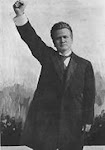The story of Hostess is nothing but an example of capital vultures pulling a Bain job on the company and its workers, then blaming the unions for their treachery and theft.Now, as the capitalistic vultures are planning on cashing in even more on the company's demise, new reports show that this was indeed planned for all along:
This is the kind of life that Mitt Romney and Paul Ryan was promoting and Scott Walker is still pushing. This is their idea of being successful and being business friendly.
Hostess would have shut down whether the unions capitulated or not. In fact, it was only the huge concessions the unions had already made that kept it around as long as this. Without those concessions, the executives would have taken the money and ran years ago.
Hostess Brands Inc. began contingency planning for a liquidation more than a year before irate bakers went on strike, court records show.Oh, and it wasn't the union's fault either:
The bankrupt Irving-based snack maker has consistently said that a strike by the bakers — members of its second-largest union — pushed it into liquidation mode. The bakers have countered that the company’s woes predate the strike.
Clearly, planning for a possible liquidation predates the strike and even predates union votes in the fall on the company’s last best and final offer.
A 32-page document filed last week in Hostess’ bankruptcy case shows that in July or August 2011 the company hired a consultant who estimated that the liquidation value of the company’s assets, on the high end, was about $522 million. The report is dated Aug. 30, 2012, and parts of it have been reported earlier.
A different consultant said in court recently that the company’s assets, including its popular brands such as Twinkies and Wonder Bread, could fetch $1 billion.
Hostess said it expects to file binding “stalking horse” bids for many of its brands in January, followed by a four-week auction process to allow competing bids. Sale closings for many brands could come as soon as mid-March, Hostess has said.
While the dissolution of Hostess may have taken Twinkie lovers by surprise, for some following the case, it had been a strong possibility for months. There were too many issues that even warmer union relations would not have changed.What this is saying in a nutshell is that the vultures figured it was time to finish off the company and take their money and run. So they planned ahead of time to file for bankruptcy and how they would make maximum profit out of the deal. Then they set up the unions by offering a contract that they new the unions couldn't accept and bargained in bad faith to make provoke a strike. They used the strike as an excuse to implement their plan of killing the company and reaping their profits.
Hostess was loaded with debt even after its predecessor company emerged from bankruptcy court in 2009. And it faced an even greater debt load when it entered bankruptcy court in January.
Even after the new bankruptcy case was filed, it needed a cash infusion. GE Capital, a key lender, has said repeatedly it wants its money back. No one stepped up to offer the cash needed to help the company emerge from bankruptcy protection or to fund much-needed capital improvements.
Also, consumer tastes have been changing while Hostess’ product lineup has remained largely the same.
“So many things had to break right for Hostess to successfully emerge from bankruptcy, beyond labor negotiations, that Hostess knew it made sense to plan for liquidation,” said Jeffrey Freund, general counsel to the bakers union.
Last year, Hostess selected FTI Consulting to look at potential proceeds and costs of a “forced liquidation” of the company’s assets following a worker strike, according to the court filing.
In November 2011, FTI prepared an analysis that also showed potential proceeds under an “orderly breakup” of the company through the sale of Hostess’ brands and assets as going concerns. Those sales would be followed by a liquidation of all remaining assets.
The “forced liquidation” was estimated to bring in up to $450 million, with $336 million available for distribution to those with claims, once the liquidation costs were subtracted.
An “orderly breakup” was estimated to bring in up to $521.7 million with $410 million available for distribution.
These vultures will probably be rewarded with high position jobs in other companies where they will feed like the parasites they are. Meanwhile, 18,000 people have gotten the shaft due to the greed of these few reprobates.















Taking down corporations, stripping out the assets, is how big business is done -- always has been.
ReplyDeleteKurt Hahlbeck was a VP at Schlitz when they used a strike to close brewery, sell off brands to highest bidders, and then liquidate the remaining assets -- HUGE interests in real estate, vineyards in Germany, and other very valuable interests.
Romney and Bain may have added some twists, but VULTURE CAPITALISM has aways been a part of American Business.
FWIW: After being part of looting Schultz, Hahlbeck went to a Milwaukee Wallpaper Distributor on S. Florida St, Republic Midwest, and help start the liquidation of that large national firm.
And in the Menominee River Valley, just below Republic Midwest, the Chicago, Milwaukee, St. Paul, and Pacific RR (Milwaukee Road) was driven into bankruptcy repeatedly making fortunes for insiders.
In the 1920's it was the "Enron" of its day -- the largest such scandal in the Nation's history.
CMStP&P was always a candy store, but at the turn of the 20th century, was a dependable, "Widows and Orphans" blue chip stock.
Then the Rockefeller/Standard Oil vultures moved in.